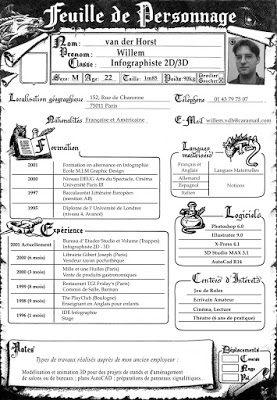[Image Credit: Robert Couse-Baker]
An advertising agency account manager friend and ex-colleague recently contacted me to ask for some advice to improve the quality of her creative briefs. She started working with a new agency and it’s a small one with no planning (or strategy) department. In her words, she has no problem writing a passable or boring brief so that’s not the issue.
She was looking for pointers to figure out where best to start and the right kind of questions to ask. I replied and I’ve been thinking about it some more since. I’m organising this in a blog post, it might be useful for more people. I’d also be glad to have some input and thoughts from more people as well to build and expand on the following ideas.
Account managers often need to write briefs that planners don’t have time for, or as in the case above smaller agencies might not have many (or any) planners around. Writing a good creative brief isn’t some kind of strategy or planning department trade secret, yet it takes time and Suits have a lot of things to do.
Heather writes about the unfortunate lack of training and development in agencies in her (highly recommended) book, Brain Surfing. I have seen training sessions to teach account managers and planners how to write creative briefs in agencies, but not everywhere unfortunately.
That said even the training sessions I’ve attended tended to be linear, going through the process of filling the agency’s template rather than helping on the way to think about a brief. I don’t mean it’s bad, because it’s natural to try and systematise processes to be more efficient in an organisation. One of the pitfalls is to end up with repetitive briefs as people go through the motions of filling the blanks, particularly when everyone involved is familiar with a client and their brand. The temptation to recycle last year’s Christmas brief to gain some time is real.
The most important pitfall is to get lazy to think. We have a lot on our minds already: too much work on, not enough time, tired, hungover, compulsively checking social media, emails to reply to, clients needing stuff, too many meetings on to get work done, thinking about non-work related stuff with your partner / kids / house / finances / etc. We don’t want to think about another thing, it takes an effort.
If we consider we’re both going to get distracted soon and that there are plenty of other important things that need our attention, then what could the most important element(s) to think about be? What could produce most of the quality of a creative brief in a minimum amount of time?
Thinking about the Pareto principle, can something along those lines apply to the process of writing a creative brief, that could be used by account managers (and planners) to be faster and more efficient when they need to be?
If we imagine 20% of the time spent on a given creative brief produces 80% of the quality, what would that 20% time represent?
Some might disagree with the premise, arguing for example that we don’t know in advance where the most valuable aspect of a creative will come from. I certainly agree the best creative briefs often aren’t the result of a linear thinking process even though that’s exactly the way most creative brief templates read.
Pareto’s principle isn’t a law, and I don’t think you can completely systematise writing a creative brief. At the same time, we all know most agencies are high pressure environments where almost everything is due yesterday, as such considering more efficient ways of getting work done seems worthy enough to me.
Because everyone likes alliterations, I think there are two core ingredients: Instructions and Inspiration.
Instructions are quite simply given by the definition of the word brief as a noun: a set of instructions given to a person about a job or task.
Creative agency work traditionally flows from the client, to the account manager, to the planner, and then to the creative team – depending on the type of brief and agency, project management, production, technical and other team members are involved in various stages.
The account manager is typically the first agency person to get the brief so they have the most control over improving it, as well as writing it efficiently.
If we take the brief as being a set of instructions as this definition states, the first way to maximise time and value is to ensure the set of instructions is as clear and explicit as possible. I’m sure we can all relate to obscure sets of instructions that accompany a cheap piece of furniture and compare that with LEGO instruction booklets (if you don’t relate, LEGO usually has better instructions than cheap furniture).
Your main avenue to improving instructions is to ask questions, and the main pitfall is in making too many assumptions.
First question is for yourself: are you clear what the instructions are?
If the answer is no, you shouldn’t expect others to understand any more than you do.
Next question: did you get everything you could from the client?
The client may well have views on what the instructions are for their brief but not necessarily. What you should be able to get from the client is to learn more about the situation with their business and brand leading to them giving you this brief. Thinking of what you are missing to make the instructions clear will inform the kind of questions you should ask (usually some flavour of what / why / where / who / when / how). In doubt ask one more question.
There will be typically be gaps between what the client told you and what you need to make the instructions clear. if there weren’t maybe they wouldn’t need you or an agency. Colleagues can sometimes help you fill a gap quickly, it is one of the chances we have of working in very collaborative environments. Someone nearby in the open space has probably worked with that client, brand or on a similar brief in the past. Avoid going to them with a blank sheet of paper though, that’s asking them to do your job, not filling gaps. Making assumptions for any missing information is your last port of call, and can often be discussed with the rest of the team.
Inspiration is defined as the process of being mentally stimulated to do or feel something, especially to do something creative.
Again, the first question is for yourself: are you inspired to answer this brief?
If not, how come you expect a creative team to be mentally stimulated to do that in your place?
In the spirit of efficiency you need at the very least one inspiring something in the brief. Arguably the more inspiring the brief is, the better the response.
An inspiring something can really show up in any section of the briefing template, though the ones “dedicated” for more inspiring elements are usually titled insight, proposition, cultural or human truth, revelation, unique message, etc. You want to give the creative team an opportunity to come up with something that will resonate with the people on the receiving end of the piece of communication.
Your main source of inspiration is the unknown, and the main pitfall is in overused words and buzzwords.
For the sake of simplicity, let’s say that if a piece of information in the brief was previously unknown or at least not obvious to you and is also interesting, the chances it is inspiring are high(er).
Of course, the something inspiring you’re looking for is related to the instructions. To solve the equation you probably need to define another factor, time is usually a good candidate. Basically research the instructions in a limited amount of time. How you research depends on what the instructions are and how much time (or other resources) you have or give yourself.
Let’s say your instructions are to promote the launch of a new kiwi flavoured toothpaste amongst young people, and you’ve given yourself two hours to find something inspiring about it. Start with what you’re most familiar with or knowledgeable about. If you’re a young person, think about the toothpaste you buy or call a friend to ask them. If you’re into fruits, look up and think about the benefits of kiwis over other fruits. If you’ve worked on other toothpaste or oral care products in the past, look at what interesting information you might already have.
So your two hours could look like this, though they can happen in any time and/or order:
- Review instructions (10 min)
- Consider what you’re familiar with (20 min)
- Research from your desk: online, research reports, etc (30min)
- Go for a walk around the office, or outside to a shop or supermarket, ask someone who knows (30min)
- Write everything you found and/or thought of, make a list (15min)
- Zone out (5min)
- Select the most inspiring / interesting thing(s) you’ve found in relation to your brief (10min)
That’s about it. You’re ready to go and brief the creative team!
(if you’re not ready, carve more time or you’ll do better next time. Practice makes perfect.)


